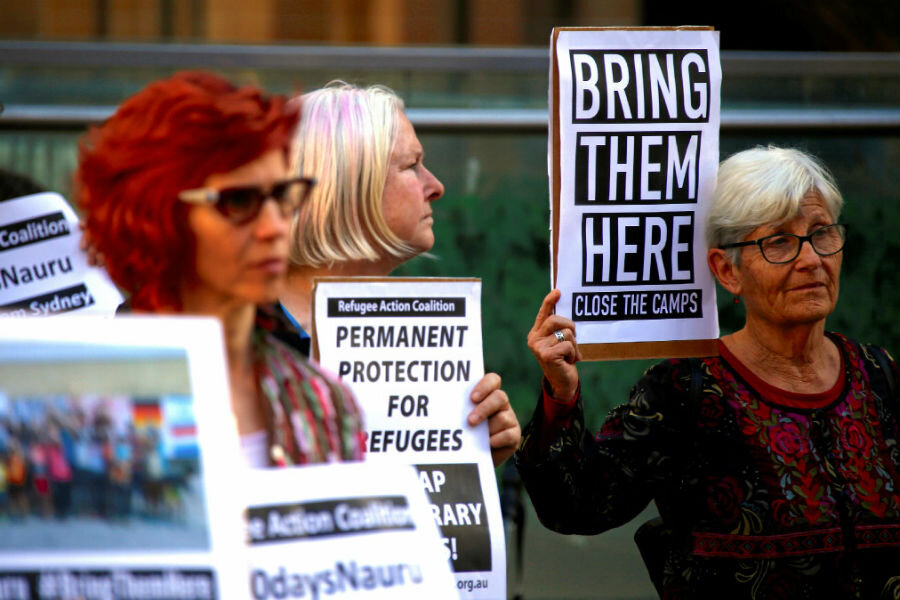Why Australia hopes to soon seal a refugee deal with United States
Loading...
The Australian government is close to sealing a deal that will send 1,800 refugees to the United States, according to reports, the result of a negotiation to exchange its asylum seekers for refugees from US-supported camps in Costa Rica.
The deal would most likely conclude before President-elect Donald Trump takes office next January, Australia's defense industry minister Christopher Pyne told The Wall Street Journal. Several sources told local paper The Australian that it may even come as early as this week.
After Tuesday's presidential election, the sense of urgency may have heightened over Australian ministers' fears that President-elect Trump’s stated desire for stricter immigration controls could quash the agreement. But for the Australian government, the passage of the settlement is crucial, especially as it is increasingly under fire for its treatment of refugees and asylum seekers in its two contentious offshore immigration detention centers for people who try to arrive by boat – a hardline strategy the government says is meant to deter migrants, and smugglers, from the dangerous journey.
“We’d all dearly love to see Nauru and Manus empty,” Mr. Pyne said, referring to Australia’s two detention centers in the Pacific islands of Nauru and Papua New Guinea’s Manus Island, which critics call Australia’s “Guantanamo Bay.”
The deal with the US would resettle detainees processed on the two islands who are found to be refugees, many of who are from Afghanistan, Pakistan, Iraq, Iran, and Sri Lanka. Some have lived on the islands with uncertain statuses for years.
Following reports over the years from newspapers and international groups such as Amnesty International and United Nations Human Rights Commission that reveal human rights violations in the camps, the Australian government has been driven to figure out what it should do with the 396 people currently in Nauru and 873 in Manus Island, according to the Australian Broadcasting Corporation.
The Nauru Files compiled by The Guardian, for example, exposed cases of children being physically and sexually assaulted by guards. Aid workers were silenced from speaking out or removing children from harm, as a former Save The Children Australia worker told NPR in August.
The need for resettlement became even more pressing after Papua New Guinea ordered the closure of the Manus Island detention center in April, claiming a breach of constitutional right to freedom for the people held there. Another $55 million deal in March to send some refugees to Cambodia collapsed.
But a path for the refugees or asylum seekers to live in Australia itself doesn’t seem likely. Since 2001, refugees and asylum seekers attempting to arrive at Australia by boat were intercepted and have been sent to the islands for offshore processing. Even if they are found to be refugees, they haven’t been able to settle in Australia. The restrictions have grown more stringent in recent years, culminating in a bill passed in the lower house of parliament on Thursday that will permanently ban any asylum seekers who arrived by boat from ever receiving an Australian visa.
“They must know that the door to Australia is closed to those who seek to come here by boat with a people smuggler: it is closed,” said Malcolm Turnbull, the prime minister of Australia. “We accept thousands of refugees and we do so willingly. But we will not tolerate any repeat of the people smuggling ventures which resulted in over 1,200 deaths at sea under the Labor party, and 50,000 unauthorised arrivals.”
Some of those currently on the islands are relieved to be free from their current conditions, The Guardian reports. But others want to see compensation for the treatment they have received.
“For me it’s hard to accept to go to America because [the Australian government] has tortured me for about four years, and now to say ‘go to America’, I question the Australian government,” Behrouz Boochani, an Iranian journalist detained on Manus Island, told the paper. “How can I get what’s right from a country like Australia that violated my human rights?”








